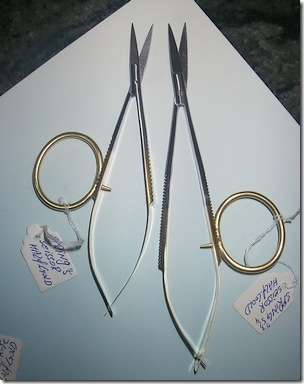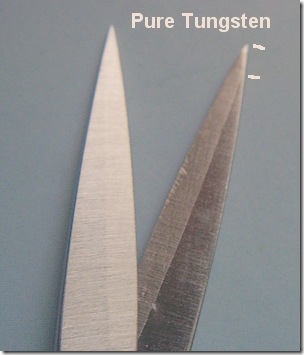The prototypes for the next generation of Sixth Finger scissors arrived on my doorstep yesterday. I’d asked for them to add a zipper so I could change it each year and obsolete everything you already own …
I figured I could offer it as a fetching facsimile to the Royal Canadian Mounties and the cord that secured their sidearm. Three and a half feet of ballistic nylon – and should you ever lay them down, they’d be available to sit on once you returned to your desk.
It certainly would reinforce the notion to keep them in your hand – the downside would be you’re having to tie standing up for the next three months.
Madison Ave calls it “branding” – affixing the image of a product into your subconscious so you can’t help but think of me when you see it. I call it a life long scar, and you’ll never be able to look at a Band-Aid or tourniquet without cringing …
The vendor has added all of the enhancements I’ve asked for and produced something quite special.
 Issue: The current flavor of scissor is a light-duty specialty scissor, with small light blades and fine tips. It’s wonderful for trout flies and medium sized flies, yet has issues with thick or bulky. Those same light blades offer a small sharp tip – but can be deflected by a heavy woven four strand yarn, or bulky chenille.
Issue: The current flavor of scissor is a light-duty specialty scissor, with small light blades and fine tips. It’s wonderful for trout flies and medium sized flies, yet has issues with thick or bulky. Those same light blades offer a small sharp tip – but can be deflected by a heavy woven four strand yarn, or bulky chenille.
Resolution: The debut of the General Purpose variant, designed to accomodate light, coarse, and heavy materials. It is equipped with a larger, heavier blade that cannot be deflected. It’s simple physics that cause the issue, and adding mass to the blade prevents it bending out of the way, and lengthening the handle allows more force to be exerted to sever large materials cleanly.
The General Purpose will be longer by an inch, half of which is in the blade area, and the balance in the handle. The spring mechanism has been shortened yet retains a crisp positive action. Even better is the blades – about twice the mass – both thicker and longer, and we didn’t have to give up the fine tips.
As I eat what I sell, I’ve already started testing the materials that proved difficult on the smaller scissors, and have been chuckling with great glee …
But I didn’t do you no favor …
 To assist both normal and this new “General Purpose” variant, I’ve also added tungsten inserts on both models, but I didn’t do you any favor by doing so …
To assist both normal and this new “General Purpose” variant, I’ve also added tungsten inserts on both models, but I didn’t do you any favor by doing so …
Tungsten Carbide is one of the hardest metals known to Man, and in scissors it makes a superior cutting edge – one that will last much longer than conventional surgical stainless.
It’s also the most brittle. One bleary-eyed late night cut where you catch the hook shank up at the scissor tip, and you can take the points clean off.
This is true of $500 surgical scissors as well as inexpensive flavor. The only known solution is to make a blunt point which allows more tungsten into the area, giving the tip greater shear strength. As fine tips are essential on a good set of scissors, blunt is unacceptable.
Having tied with Tungsten inserts and expensive surgical scissors for the last 25 years, I can vouch for the fragility of the tip. Bill Hunter sold me my first pair and mentioned, “you’ll have to relearn your scissor work, or you’ll tear these up.”
I did. But at the cost of the first pair.
The second set lasted 20 years, so the transition is easy enough to make, but only after you’ve destroyed at least one set. In short, you learn to make all cuts away from the shank – never cutting towards the hook.
We’ve also opted for an adjustable screw to aid quick disassembly for sharpening. Medical scissors attempt to braise or grind the screw to prevent seams that allow bacteria to collect on the scissor surface. This prevents the screw from turning – and tightening the screw is often not possible.
As all scissors eventually need adjustment (except in the medical profession where they’re often discarded) – I’ve got a slightly different screw assembly on these prototypes to see if I can adjust it in the future.
Summary: For 2010 I’ll be offering three models of the Sixth Finger; a larger General Purpose scissor with Tungsten inserts, the current model of surgical stainless, and a variant of the original scissor also with Tungsten inserts.
Pricing and availability should be around the mid-March timeframe. I’m attempting to bring the price in around the $25 dollar mark for the Tungsten and larger General Purpose flavors.
… and my thanks for the many helpful comments and feedback on these “children” of mine. Many of you have been quite candid about changes you’d like – or features that suited you, and I’ve rolled all that into this second generation of product.
Based on what testing I’ve completed, they’ll go through your jeans and a couple inches of Gluteus before you have time to draw a breath …
Testers: Around March I’ll be sending out 10-12 sets of the new scissors to some of the existing owners as a test group. If you’d like to test one model over another I’ll inquire before I send them.
I’d like to upgrade everyone, but the economics say otherwise.
Full Disclosure: I came up with the bright idea, and use them daily, to the exclusion of all other scissors. But as I’m also the vendor – I am not to be believed.
Tags: Sixth Finger Scissor, Product Roadmap, fly tying scissors, Tungsten Carbide, adjustable screw hole, fine tips, Bill Hunter, RCMP, shameless commerce

about damn time you upgraded to some brownliner scissors.
so how do they hold up against copper wire?
is there some secret to learning to hold these while tying?
@roughfisher – Tungsten inserts will not dent them “Iron Maiden O’ Death” flies you’ve been seen with – nor will they cut tungsten beads in half, so you can have twice as many…
@Ray – depends on the gauge of wire – most fly shop stuff is 36 Gauge, and the finest diameter being 38. Neither will be an issue.
Roughfisher uses much heavier 34 gauge – with tungsten inserts all of the scissors can part that with ease. I would only use the general purpose (larger) scissor to do that however.
Small and fine should be used for small and fine cutting, that will allow the scissors to last for many years. It’s the “proper tool for the proper job” idea.
Drop me a note, and I’ll work with you on the scissor position in your hand piece.
FWIW, I tie with a lot of Ultrwire or equivalent size ranges are typically 28 gauge for the medium size, and 26 gauge for the large. Not sure what sizes small or brassie are but they are likely 30 and 32 gauge respectively.
that is a good design, i think that the extra mass in the blades is a great idea.
Nice! Good to see innovation in such a much needed tool for tying!
Cool! I can’t wait to get my hands on a heavier pair of these scissors. I have been using mine almost exclusively since I received them. I think a heavier version would be the way to go. The tungsten option would be a nice touch too.